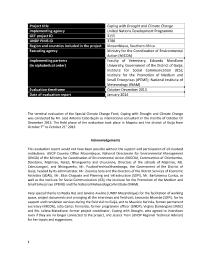
Terminal Evaluation of Coping with Drought and Climate Change
Completedon 5 Jan, 2014
Evaluation Plan
Planned End Date
Jan 2014
Evaluation Type
Project
Management Response
Yes
Evaluation Budget
$12,655
Evaluation Title
Terminal Evaluation of Coping with Drought and Climate Change
Atlas Project Number
00057849
Plan Period
Status
Completed
Type
Project
Plan Date
23 Jan, 2014
Completion Date
5 Jan, 2014
Budget
$12,655
Expenditure
$15,000
Source of Funding
GEF/SCCF
Management Response
Yes
Quality Assessment
Yes
Joint Programme
No
Joint Evaluation
No
GEF Evaluation
Yes
Expand
Stakeholders
Government, Minstry of Environment, National Institute of Meteorologymicro-finance institutions, UNCDF, CSOs
Countries
Mozambique
Atlas Project Number
00057849
Plan Period
Status
Completed
Type
Project
Management Response
Yes
Plan Date
23 Jan, 2014
Quality Assessment
Yes
Completion Date
5 Jan, 2014
Joint Programme
No
Joint Evaluation
No
Budget
$12,655
GEF Evaluation
Yes
Expand
Expenditure
$15,000
Stakeholders
Government, Minstry of Environment, National Institute of Meteorologymicro-finance institutions, UNCDF, CSOs
Source of Funding
GEF/SCCF
Countries
Mozambique
Output 5.4. Preparedness systems in place to effectively address the consequences of and response to natural hazards (e.g. geo-physical and climate related) and man-made crisis at all levels of government and community
1: Others


